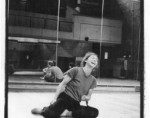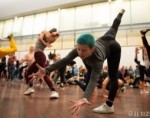
Photo: Alexander Iziliaev
In Conversation: Angel Corella
by Lisa Kraus
This summer, Dance Magazine invited TD Editor Lisa Kraus to write a short piece about Ángel Corella, responding to his newly-announced appointment as the next artistic director of Pennsylvania Ballet. As PAB embarks on its first week of performances with Corella at the helm, here are some outtakes from their interview.
Lisa Kraus: What drew you to Pennsylvania Ballet?
Ángel Corella: I’ve followed the company for quite a while for many different reasons, especially because when I started with American Ballet Theatre my sister and her ex-husband were dancers with the company. I used to visit them all the time so I’m quite familiar with the company. It’s a wonderful company with wonderful dancers and a great repertoire.
LK: You are coming from having directed Barcelona Ballet in Spain. I understand that funding was challenging there.
AC: Spain as a country is very focused on sports and puts most of its money into them, especially soccer. They don’t invest in culture. Not only that, the tax deduction law doesn’t allow you to go in search of private donors to support the arts. So if you’re an artist in Spain you are going to disappear…everyone leaves the country! Like Placido Domingo and all the great established artists, they all left the country because there’s not any kind of support from the government. There’s a lot of corruption. It’s very, very sad.
LK: So the prospect of leading an established company with donors and a strong infrastructure in place must have been appealing.
AC: That does change things a lot because you can focus a lot more on the artistic side and not so much on the executive side. Even so, I think that David Gray, the new Executive Director, and I are going to work hard to not only maintain what the company has but also to raise the budget so we can feel comfortable in doing more things and maybe in the future extending the number of dancers in the company and allowing us to do different projects which will be very exciting for audience and for the dancers as well. I think for us it’s going to be a new era. I’m trying to get used to saying “us” and I’m taking it with all the excitement that I can.
LK The excitement is very palpable here. People are really looking forward to seeing what will happen. What are your priorities, where do you want to focus your attention to first and foremost?
AC: In general, the beginning is always a little more difficult because you have to get used to each other, Like getting to know a partner for a first time, probably the first few weeks are going to feel a bit strange. But I hope that it doesn’t happen. I’m going in with all my positive energy, and all my willingness to make the process of getting together is as smooth as possible.
And then I’ll start working with the dancers on improving their technique, on improving their artistry and making them the best that they can be. And in general making the whole environment as exciting and enlivened as possible because I think that the company needs a new beginning.
Roy [Kaiser, PAB’s former artistic director] has done a great job, he has done wonderful things with the company. The repertoire that the company has until now, it’s stunning, outstanding, really, really great.
LK: The quality of your own dancing is so superlative. How do you envision helping PAB dancers make the leap from being very good to being brilliant—to something closer to what you know how to do?
AC: It’s passion. It’s injecting a huge dose of passion. Sometimes along the way we lose that passion and that love for dance. And it’s going onstage and not worrying about anything other than just connecting with the audience and sharing directly with them, as human beings, our souls and the way we feel. When we forget why we dance is when things start to get a little bit stale. I think that passion is the thing, not that dancers are missing but that tends to get distracted by technique which is something that today is very appreciated by some dancers. They think that by doing a lot of turns or a lot of very high jumps that that’s going to excite the audience and that’s what the show is about. But I think that the show is about the communication between human beings and to say something with who you are and try to connect with the audience. So that’s mainly what I’m going to be focusing on.
I’m going to help them to improve their technique because nobody’s perfect, even the best of the best technical dancers in the world. They will have to still be working every day to maintain or get better. But, I’ll focus a lot on the artistic side so that people when they go to see them will feel like they’re having a conversation with them from the house.
LK: You’ve mentioned bringing a new audience to the ballet through commissioning new work and through outreach. What are you thinking about?
AC: There’s programming and the type of choreography you bring to the company. There are ways to do it by doing public appearances. For example once in Argentina there was an open performance on a very broad avenue--Cinco de Mayo Way. And Julio Bocca and Maximiliano Guerra and a lot of people went down and danced. They said that it was close to 700,000 people watching. The organizers put cameras and screens all over the place. And that made the whole city get involved and made dance one of the most important things in the country. Those dancers are heroes there and everybody knows who they are. So I think there are many different ways you can get citizens involved, having them learn about what dance is and that it’s not only elitist. Everyone should enjoy dance and the arts—it’s within reach for every single person.
LK: When thinking about commissioning new dances, what makes you interested in specific choreographers working today? What do you look for?
AC: In most of the cases it’s creativity. I think a choreographer is born. When they have something to say and a vocabulary that is unique, that’s when it makes a choreographer. People who can put steps together—there are many of them. But people who have a specific way to say something are very few, counted on one hand. I’m going to work with them and try to discover new ones.
There is always someone around waiting to be discovered so we will try to do some workshops that will attract new choreographers, younger choreographers, to do triple bills. Maybe get the audience involved as well. Maybe we’ll put papers at the entrance so they can vote which one of the three ballets they like the most. We’ll see. The possibilities are endless.
LK: It sounds as if you’re really energized and excited about all the possibilities at PAB. Is there anything else you want people to know?
AC: I’m going to try to do my best to make it the best company in the world. I hope that everyone can make it to Philadelphia to support the company and to see what we’re going to do because we’re going to try to create a lot of excitement. I can’t wait to see everyone there.
By Lisa Kraus
October 11, 2014







.png)


